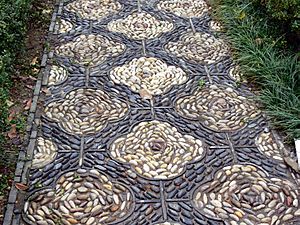Pebble facts for kids
A pebble is a small, rounded piece of rock. It's bigger than a granule (which is 2 to 4 millimeters wide) but smaller than a cobble (which is 64 to 256 millimeters wide). Pebbles usually measure between 2 and 64 millimeters across. When many pebbles are stuck together to form a rock, it's called a conglomerate.
Long, long ago, people used pebbles to make some of the very first tools! These are called pebble tools.
A beach that is mostly covered with pebbles is known as a shingle beach. These beaches are special because they help protect the land from strong waves. They also provide a home for different kinds of plants and animals.
Pebbles come in many different colors and can have interesting patterns, like streaks of quartz or other minerals. Most pebbles are smooth because they've been tumbled by water. However, if they don't touch the water often, they might have rougher spots or even lichen growing on them.
Contents
Where to Find Pebbles
Pebbles can be found in a few different places. You'll see them on beaches along oceans and seas. You can also find them inland, in places where ancient seas used to be. When the water dried up, the pebbles were left behind. Lakes and ponds can also have pebbles.
Pebbles also form in rivers. As rivers flow, they carry rocks downstream, smoothing them along the way. These pebbles can then travel into estuaries and eventually reach the sea, where they continue to get smoother.
Beach pebbles and river pebbles look a bit different because of how they are formed.
Beach Pebbles
Beach pebbles are made over a long time as ocean water washes over loose pieces of rock. This constant movement makes them very smooth and round. They are usually between 2 and 50 millimeters in size. You can find them in many colors, from clear white to black, and also yellow, brown, red, and green.
Many pebble beaches are found along the Pacific Ocean coast, stretching from the United States all the way down to Argentina in South America. Other pebble beaches are in northern Europe, like along the Norwegian Sea, and also in the U.K. and Ireland. You can also spot them on the shores of Australia, Indonesia, and Japan.
River Pebbles
Inland pebbles, also called river pebbles or river rock, are usually found along the edges of large rivers and lakes. These pebbles become smooth as the flowing river water tumbles them along the bottom and sides of the river.
How smooth and what color a river pebble is depends on things like the type of soil along the river banks, the chemicals in the water, and how fast the current flows. River currents are usually gentler than ocean waves, so river pebbles are often not as smooth as beach pebbles. The most common colors for river pebbles are black, gray, green, brown, and white.
How People Use Pebbles
People use beach and river pebbles for many things, both outside and inside their homes. Pebbles can be sorted by color and size. They can also be polished to make them even smoother and bring out their colors.
Outside, pebbles are often used for landscaping, in construction, and as decorations. They are great for covering walkways and driveways, around swimming pools, in plant pots, and on patios. Pebbles are also used to create "water-smart" gardens in places where water is scarce. Small pebbles can even be used to make gardens on building rooftops!
Inside, pebbles can be used as bookends or paperweights. Sometimes, large pebbles are even turned into fun "pet rocks" for children.
Pebbles in Space
Scientists have found rocks on Mars that look like they were once pebbles! These rocks were discovered by NASA's Mars rover, Curiosity. They believe these pebbles formed in an ancient streambed on Mars. The pebbles range in size from tiny sand particles to golf balls. This discovery suggests that a stream once flowed on Mars, moving at a walking pace and being about ankle to hip deep.
Images for kids
See also
 In Spanish: Canto rodado para niños
In Spanish: Canto rodado para niños








